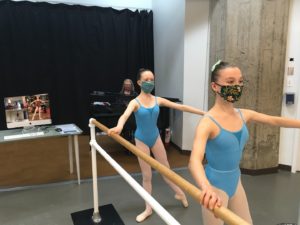
By Elaine Gaertner
For a piano accompanist, playing for a dance class over the internet poses a whole new set of variables and challenges. In a virtual class, with dancers in their own spaces, potentially around the globe, technical restrictions mean they hear the music a fraction of a second or more after it leaves the piano, each dancer at a different interval of time. The devil himself could not have invented a more diabolical torture for an accompanist.
During a typical studio class, pianists choose their music after a teacher has physically demonstrated or described the combination of steps to the students. The name of each exercise triggers the pianist’s response, with a subset of possibilities to consider based on their understanding of the rhythm and dynamics needed to support the movements. The next priority is tempo, which the pianist fixes in their mind based both on the demonstration and their familiarity with the teacher’s preferences. Some teachers expect the tempo to be exactly as demonstrated, while the majority speed through their demonstration and expect the pianist to adjust the tempo. Another variable is the length of the musical phrases as they relate to the exercise and the total number of bars of music to be played.
In addition, there will be feedback from the dancers. Their nuances in interpreting the music — the way they begin and end each phrase, and subtle adjustments to tempo throughout the exercise — will continue to influence the accompaniment. Over the internet, though, these kinds of visual cues that have guided the pianist’s touch for so many years are gone.
As an accompanist for virtual classes, it was initially my belief that I could choose a dancer — visible on my computer, placed nearby — who appeared to have the fastest and most stable internet connection, with the least delay in hearing my actual tempo. I would then pin this dancer in full view and try to use them as my guide. However, no matter how minimal the delay, even the slightest lag required an excruciating mental juggling act on my part.
Since watching the dancers on our computers is confusing, we can no longer do this. Instead, the accompanist must retain every detail of each exercise as it is demonstrated or explained, and put together a mental image of an ideal dancer executing the exercise to the music. This will be an exquisitely musical individual who reacts to the ebb and flow of the music, responds to the most minute detail and uses the music as inspiration for each movement, a dancer stored in memories carried from the thousands of dancers who have been our inspiration in past in-studio live classes. This imagined dancer must serve as the guide for the phrases, crescendo and diminuendo, articulation, sustain and detachment of the pedal, and the slight ritardando at the recovery from a fondu or after turning to the other side.
However, we cannot ignore the screen entirely, as that would detach us from the experience of playing for actual dancers. We must be conscious that there are people dancing on the screen without analyzing their movements in relation to our music. This is another major adjustment, one which requires developing a detached mind-set that until now has been anathema to any good dance musician.
Seeing movement on the screen keeps us aware that dancers are reacting to our music. However, in a virtual class, the latency obliges us to rely upon an imagined dancer to guide our touch rather than the actual dancers in the class. It takes practice. A new era, a new skill set, but accompanists can still remain irreplaceable partners in the ballet class. A recording can only indicate a beat. An accompanist fills in what is between the beats: dynamic contrast, inflection, articulation and directionality in the phrases, creating true complicity between dance and music — even virtually.
Tech specs
Any pianist with a cell phone, tablet or computer can accompany virtually, but adding to these basic tools will improve the experience for them and the students. An external microphone will enhance the sound dependent upon the quality of the microphone and the bandwidth of the internet connection. The amount of data transmitted over the internet is limited by many factors, so spending thousands of dollars on a studio quality microphone would be wasted. I would recommend not spending more than $150.
A digital piano (which used to be called an electric piano) will need a box to convert the signal from analog to digital in order to connect the sound directly through a computer, which also costs in the range of $150.

These additions maximize what can be done technically at this point in time, but both are limited by latency, the lag between the time the signal leaves one device and arrives at another.
Certain Zoom (or other connectivity software) settings should be set to allow for “original sound” in order to prevent the microphone from compressing the sound of the music. “Auto” microphone settings should be disabled.
The rollout of 5G (fifth-generation cell technology) promises speeds 10-100 times faster than today, with massive bandwidth and lower latency (delay). In many western countries, as well as China, Japan and South Korea, the transition is already underway. However, we still will be burdened by internet lag for at least another five or more years, according to experts in the field.
Elaine Gaertner began accompanying ballet classes for Les Ballets Jazz de Montréal in 1980. She has been on the faculty of the École supérieure de ballet de Québec since 1986, where she teaches a course leading to a diploma in ballet accompaniment.
Tags: ballet students COVID-19 École supérieure de ballet de Québec Elaine Gaertner international dance news online dance classes piano accompanists